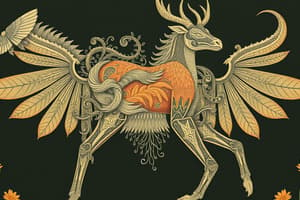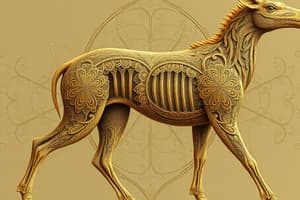Podcast
Questions and Answers
Which characteristic is least useful when classifying an organism into its major group?
Which characteristic is least useful when classifying an organism into its major group?
- Germ layers
- Symmetry
- Habitat (correct)
- Mode of nutrition
How does polymorphism contribute to the survival of certain species like the hydra or sea anemone?
How does polymorphism contribute to the survival of certain species like the hydra or sea anemone?
- Reduces competition for resources within the colony
- Allows for specialization of individuals within a colony, enhancing overall efficiency (correct)
- Enhances individual camouflage against predators
- Increases the rate of sexual reproduction
What structural adaptation primarily enables a bony fish, such as a tilapia, to maintain buoyancy in the water column?
What structural adaptation primarily enables a bony fish, such as a tilapia, to maintain buoyancy in the water column?
- Highly developed sensory organs
- A streamlined body shape
- A swim bladder that can be inflated or deflated (correct)
- A cartilaginous skeleton
Which of the following is the most significant difference in the function of the electron microscope compared to a light microscope?
Which of the following is the most significant difference in the function of the electron microscope compared to a light microscope?
Why is the absence of a digestive system an adaptation to the parasitic lifestyle of a tapeworm?
Why is the absence of a digestive system an adaptation to the parasitic lifestyle of a tapeworm?
Flashcards
Symmetry
Symmetry
The arrangement of body parts around a central axis.
Germ Layers
Germ Layers
Layers of cells formed during embryonic development (ectoderm, mesoderm, endoderm).
Polymorphism
Polymorphism
The presence of two or more different forms or distinct types of individuals within the same species.
Mitochondrion Function
Mitochondrion Function
Signup and view all the flashcards
Chloroplast Function
Chloroplast Function
Signup and view all the flashcards
Study Notes
- The exam covers various topics in Lower Sixth Biology.
- Question 4 is compulsory, and students must answer any 3 other questions.
Symmetry
- Symmetry refers to the balanced arrangement of body structures.
- Types include radial, bilateral, and asymmetry.
Germ Layers
- Germ layers are primary layers of cells formed during embryogenesis.
- These layers differentiate into specific tissues and organs.
- The three main germ layers are ectoderm, mesoderm, and endoderm.
Polymorphism
- Polymorphism is the occurrence of different forms or distinct types of individuals within the same species.
- This can include variations in morphology, behavior, or other characteristics.
Octopus vs. Squid
- Octopuses have a rounded body without fins, while squids have a torpedo-shaped body with fins.
- Octopuses typically have eight arms, while squids have eight arms and two longer tentacles.
- Octopuses often live in rocky dens, while squids are usually free-swimming.
Bony Fish (Tilapia) Diagram
- A well-annotated diagram should include:
- Fins (dorsal, pectoral, pelvic, anal, caudal)
- Operculum covering the gills
- Lateral line
- Scales
- Mouth
- Eyes
- Swim bladder (internal)
- Vertebral column (internal)
Differences: Bony Fish vs. Cartilaginous Fish
- Bony fish have a bony skeleton, while cartilaginous fish have a skeleton made of cartilage.
- Bony fish possess an operculum covering their gills, while cartilaginous fish have gill slits.
- Bony fish typically have a swim bladder for buoyancy, while cartilaginous fish lack a swim bladder.
- Cartilaginous fish possess placoid scales, while bony fish have different types of scales (e.g., cycloid, ctenoid).
- Bony fish typically reproduce via external fertilization, while cartilaginous fish often use internal fertilization.
Mitochondrion Adaptations
- The inner membrane is folded into cristae, increasing the surface area for ATP production.
- Contains enzymes involved in cellular respiration and ATP synthesis.
- Has its own DNA, enabling it to produce some of its own proteins.
Chloroplast Adaptations
- Contains chlorophyll, the pigment that captures light energy for photosynthesis.
- Has a double membrane structure.
- Contains thylakoids arranged in grana, increasing the surface area for light-dependent reactions.
Bacterial Cell vs. Animal Cell
- Bacterial cells are prokaryotic and lack a nucleus, while animal cells are eukaryotic and have a nucleus.
- Bacterial cells have a cell wall, while animal cells do not.
- Animal cells contain membrane-bound organelles (e.g., mitochondria, endoplasmic reticulum), which bacterial cells lack.
- Bacterial cells are smaller and simpler in structure compared to animal cells.
- Animal cells reproduce through mitosis or meiosis, while bacteria reproduce through binary fission.
Electron Microscope vs. Light Microscope
- Electron microscopes use beams of electrons to create an image, while light microscopes use light.
- Electron microscopes have a much higher resolution than light microscopes.
- Electron microscopes can achieve much higher magnification than light microscopes.
- Electron microscopy requires specialized sample preparation, often involving fixation and staining with heavy metals. Light microscopy can use live samples.
- Electron microscopes are much more expensive than light microscopes.
Organism Classification
- Cockroach:
- Major Group: Arthropoda
- Subgroup: Insecta
- Habitat: Terrestrial
- Earthworm:
- Major Group: Annelida
- Subgroup: Oligochaeta
- Habitat: Terrestrial (soil)
- Sea Anemone:
- Major Group: Cnidaria
- Subgroup: Anthozoa
- Habitat: Marine
- Hydra:
- Major Group: Cnidaria
- Subgroup: Hydrozoa
- Habitat: Freshwater
- Crab:
- Major Group: Arthropoda
- Subgroup: Crustacea
- Habitat: Marine/Aquatic
- Starfish:
- Major Group: Echinodermata
- Subgroup: Asteroidea
- Habitat: Marine
- Beef Tapeworm:
- Major Group: Platyhelminthes
- Subgroup: Cestoda
- Habitat: Parasitic (in host intestines)
- Fig Fish
- This appears to be a typo, and should likely be Fig Wasp. Please ask for clarification, as it can also be a general term for fish found in mangroves.
- Major Group: Arthropoda
- Subgroup: Insecta
- Habitat: Within figs (specialized)
- Tadpole:
- Major Group: Chordata
- Subgroup: Amphibia
- Habitat: Aquatic
- Fruit Fly:
- Major Group: Arthropoda
- Subgroup: Insecta
- Habitat: Terrestrial
Tapeworm Adaptations for Parasitic Life
- Tapeworms possess hooks and suckers for attachment to the host's intestinal wall.
- They lack a digestive system and absorb nutrients directly from the host's digested food.
- Tapeworms have a long, flattened body to increase surface area for nutrient absorption.
- They are hermaphroditic, allowing for self-fertilization if necessary.
- They produce a large number of eggs to increase the chances of infecting a new host.
Tapeworm Control
- Practicing good hygiene, including thorough handwashing.
- Properly cooking meat to kill tapeworm cysts.
- Ensuring proper disposal of human waste to prevent contamination of animal feed and water sources.
- Controlling intermediate hosts, such as fleas, in pets, as they can transmit the parasite.
Studying That Suits You
Use AI to generate personalized quizzes and flashcards to suit your learning preferences.
Description
Explore key biology topics for Lower Sixth, including body symmetry types (radial, bilateral, asymmetry), the roles of ectoderm, mesoderm, and endoderm germ layers, polymorphism, and octopus versus squid characteristics.




